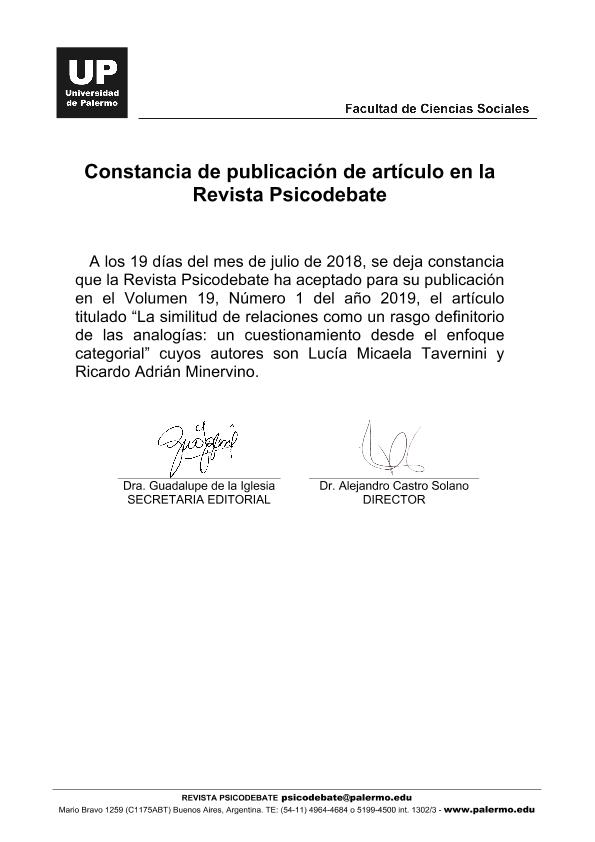Artículo
La teoría de proyección de la estructura postula que el componente central en la realización de una analogía es detectar que dos situaciones comparten un sistema de relaciones similares. Se llevaron a cabo dos experimentos con el objetivo de evaluar la hipótesis del enfoque categorial de que la similitud de relaciones no constituye una condición necesaria ni suficiente para que las personas juzguen que dos hechos son análogos, sino que el factor determinante es la pertenencia o no de los hechos comparados a una misma categoría relacional. En ambos experimentos 18 estudiantes de Psicología recibieron un hecho base y dos hechos meta en los que se describían eventos simples, y debían evaluar cuán análogo al hecho base encontraban a cada hecho meta. En el Experimento 1 los dos hechos meta incluían relaciones que no eran similares a las del hecho base. Sin embargo, mientras que en el primer hecho meta el objeto al que se aplicaba la acción descrita por la relación convertía al hecho en un ejemplar de la categoría relacional aplicable al base, el objeto del segundo hecho meta lo convertía en un ejemplar de una categoría alternativa. El Experimento 2 tuvo la misma estructura que el primero, con la diferencia de que las relaciones base y meta eran similares. En ambos experimentos, los resultados mostraron que el primer hecho meta fue considerado análogo al hecho base, pero no el segundo. Esto evidenció que el parecido de relaciones no es necesario (Experimento 1) ni suficiente (Experimento 2) para considerar que dos hechos son análogos y que, en cambio, el criterio que emplean las personas para determinar que dos hechos son o no análogos es el de pertenencia categorial. Se discuten las implicaciones de estos hallazgos para la formulación de modelos teóricos y computacionales sobre el pensamiento analógico. The structure-mapping theory posits that the central component in establishing an analogy is to discover that two situations share a system of similar relations. Two experiments were performed to evaluate the hypothesis of the categorical approach that relational similarity does not constitute a necessary nor a sufficient condition for people to judge that two facts are analogous, and that the determinant factor is whether or not the compared facts belong to a common schema-governed category. In both experiments, 20 psychology students received a base fact and two target facts describing simple events, and they had to evaluate how analogous the base and each of the target facts were. In Experiment 1 both target facts included relations that were not similar to those included in the base fact. However, while in the first target fact the object to which the action described by the relation was applied made the whole fact became an exemplar of the schema-governed category applicable to the base, the object of the second target fact made it became an exemplar of an alternative schema-governed category. Experiment 2 has the same structure than the first one, with the only difference being that base and target relations were similar. In both experiments results showed that the first target fact was considered analogous to the base fact, but not the second one. This evidenced that relational similarity is not necessary (Experiment 1) nor sufficient (Experiment 2) to consider that two facts are analogous, and that, instead, the criterion employed by people to determine that two facts are or are not analogous is category membership. We discussed the implications of these results for the development of theoretical and computational models on analogical thinking.
La similitud de relaciones como un rasgo definitorio de las analogías: Un cuestionamiento desde el enfoque categorial
Título:
Relational similarity as a defining feature of analogies: A questioning from the categorical approach
Fecha de publicación:
06/2018
Editorial:
Universidad de Palermo. Facultad de Ciencias Sociales
Revista:
Psicodebate
ISSN:
1515-2251
e-ISSN:
2451-6600
Idioma:
Español
Tipo de recurso:
Artículo publicado
Clasificación temática:
Resumen
Palabras clave:
ANALOGÍA
,
CATEGORÍA RELACIONAL
,
RELACIONES
,
SIMILITUD
Archivos asociados
Licencia
Identificadores
Colecciones
Articulos(IPEHCS)
Articulos de INSTITUTO PATAGONICO DE ESTUDIOS DE HUMANIDADES Y CIENCIAS SOCIALES
Articulos de INSTITUTO PATAGONICO DE ESTUDIOS DE HUMANIDADES Y CIENCIAS SOCIALES
Citación
Tavernini, Lucía Micaela; Minervino, Ricardo Adrian; La similitud de relaciones como un rasgo definitorio de las analogías: Un cuestionamiento desde el enfoque categorial; Universidad de Palermo. Facultad de Ciencias Sociales; Psicodebate; 19; 1; 6-2018; 62-76
Compartir
Altmétricas




